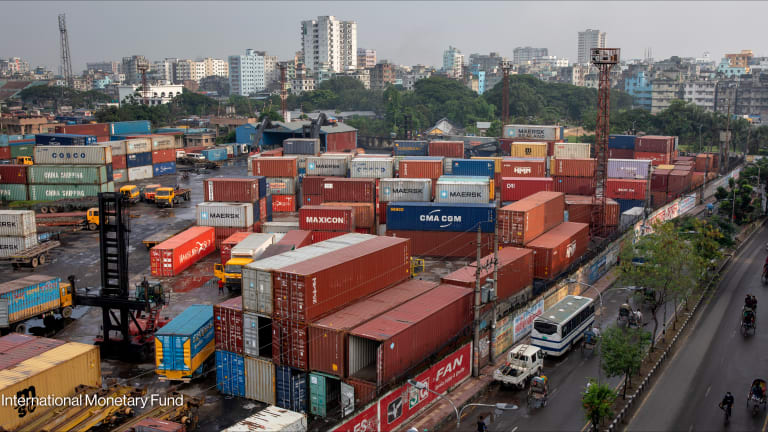Devex explores EuropeAid funding priorities in Asia
As part of its EuropeAid Funding Insights series, Devex explores 1.4 billion euros ($1.57 billion) worth of European Union planned development activity in Asia. Use our interactive guide to find out where and how the money is being distributed.
Asia and the European Union are major trading partners. With average gross domestic product growth at more than 5 percent, Asia’s commercial importance to Europe is continuing to grow. But despite its rapid development, Asia still faces major structural and social challenges, with as much as 20 percent of some national populations living in extreme poverty. These dual focuses — economic and trade relations; and development and cooperative programs — form the basis of EU-Asia strategic relations. As part of its ongoing EuropeAid Funding Insights series, Devex has analyzed nearly 1.4 billion euros ($1.57 billion) worth of EU planned development activities in Asia during 2016 and early 2017, identifying where the money is going, and how. Explore the data in our interactive visualization. The basis of development cooperation between the EU and Asia is the Regional Programming for Asia Multiannual Indicative Programme 2014 - 2020, which guides work in the areas of sustainable development, regional integration and poverty reduction, among others. Within this, the EU’s main tool to tackle these challenges is the Development Cooperation Instrument, or DCI, a broad funding instrument containing thematic budget lines — such as the Global Public Goods and Challenges Program, or GPGC, which focuses on economic, social and environmental development activities. Here, we examine EuropeAid funding commitments, development priorities and procurement modalities by analysing planned projects released between January 2016 and April 2017. We have drawn this data from the Asian Multiannual Regional and Country Indicative Programmes and its related “Action Fiches” — operational documents laying out planned projects. We also take a special look at the single largest Asian funding activity that EuropeAid released during this time — 200 million euros ($224 million) of budget support to the government of Afghanistan. To read more about our methodology, click here. The total funding destined for Asia during this time period — including the Central, South, Southeast, East and Pacific regions — is 1.382 billion euros ($1.55 billion), spread between 195 activities. Remember that these figures are indicative: budget figures may change as EuropeAid and its partners move toward procurement. Here’s what the data shows. Focus on: the Development Cooperation Instrument The DCI is the principal funding instrument through which EuropeAid will fund activities in Asia. DCI funding to Asia from the documents analyzed amounted to just over 1 billion euros ($1.12 billion) for 113 funding activities. Of that, 988 million euros ($1108 million) were channeled through geographic programs, and 30 million euros ($33.6 million) through the thematic GPGC program. The 21.5 million euro ($24.1 million) Bhutan Rural Development and Climate Change Response project, included in these figures, is a good example of GPGC’s typical project focus on sustainable environmental and human development. Geographically, the funding was distributed across Asia’s sub-regions, with some notable country concentrations. Afghanistan will receive 78 percent of Central Asia’s 363.5 million euro ($407.7 million) allocation, and of that, 200 million euros ($224 million) were the EU’s 2016 annual contribution to budget support for the Afghanistan State Building Contract, or SBC — keep reading for a closer analysis of this. Vietnam will receive 70 percent of East Asia and the Pacific’s 168.1 million euro ($188.5 million) allocation, all of which will go to the Energy Sector Policy Support Program. Only in the South Asia region is there a broad distribution of funding across countries, with Pakistan, Nepal, Bangladesh, Bhutan and Sri Lanka all allocated between 40 and 95 million euros ($44 and $106 million) of funding each. DCI funding to Asia in our data is also sectorally diverse. Energy is a key focus area, including the Vietnam project discussed earlier, as well as the multiregional SWITCH II-Asia program, which aims to promote sustainable growth and mitigate climate change. Other highly funded sectors include rural development, governance and economic development — though in all those cases, funding is well distributed across different projects and countries. In terms of management modality, most of the DCI funding to Asia in our data — 68 percent — will be directly managed, meaning that EuropeAid will oversee the procurement process for the funding. The procurement process for the remaining 32 percent will be “indirect,” entrusted to various management agencies. The agencies entrusted with the most Asia-bound DCI funding include international financial institutions — largely the World Bank, with 126 million euros ($141 million) — and various European national development agencies, including the German, French and British aid departments. Which other funding instruments is EuropeAid using in Asia? The remaining 365.6 million euros ($410 million) of Asia-bound EuropeAid funding in our data belongs to a variety of funding instruments, including the European Development Fund, or EDF, the EU General Budget, the Partnership Instrument, the Asia and Central Asia Instrument and the Instrument for Nuclear Safety Cooperation. We will examine funding from these sources as a group, but encourage you to use the links to learn more about the purposes and rules of each source of funding. Of that 365.6 million euros ($410 million), 67 percent — or 242 million euros ($271 million) — is headed to the East Asia and Pacific sub-region, largely due to two large projects in the small country of Timor Leste: a 138 million euro ($154million) Public Finance Management and Oversight, or PFMO, project managed by the Camões Instituto da Cooperação e da Língua, and a 27 million euro ($30 million) Partnership for Sustainable Agro-Forestry managed by the International Labour Organization and German aid agency, GIZ. Two projects in Papua New Guinea boost the sub-region by a further 64.2 million euros ($72 million): The PNG National WASH Policy, managed by UNICEF, and Support Programme to EU-PNG Cooperation, funded by the EDF. The sectoral division of this remaining funding is skewed towards governance, which is allocated 42 percent, or 152 million euros ($170 million), largely due to the large PFMO project in Timor Leste. Outside this, migration is also a key focus area. Nearly 96 million euros ($107.6 million) are allocated to Afghanistan (beyond the State Building Contracts budget support), Pakistan, and Bangladesh for sustainably returning and reintegrating migrants into their home communities. A special look at Afghanistan and State Budget Contracts The single largest Asian funding activity that EuropeAid released between January 2016 and April 2017 was 200 million euros ($224 million) of budget support to the government of Afghanistan. The country as a whole was allocated over 366 million euros ($410 million) by EuropeAid during the same time period, more than any other country worldwide. Much of EuropeAid’s cooperation with Afghanistan has been guided by the “state building contract” framework. State building contracts, or SBCs, are instruments and agreements used by the European Union to provide budget support to the governments of fragile and conflict-affected states. Their purpose is to offer fragile states assistance that will enable them to overcome short-term volatilities, and to take longer term steps towards stability through “state building.” This 200 million euros ($224 million) of budget support represents the EU’s first SBC with Afghanistan, and was signed in October last year. The funds were earmarked for disbursement over two years beginning in 2017, as part of the EU’s Multi-annual Indicative Program for Afghanistan, which commits 1.4 billion euros ($1.57 billion) to the country between 2014 and 2020. It is intended to support four key areas: Agriculture and rural development, health, rule of law and democratization. This is just part of the story of EuropeAid’s activity in Asia. To analyze the data yourself, check out our interactive visualization and the many types of EuropeAid funding data available on the Devex website, including early information from the European Commission and details of each EuropeAid planned activity in the Funding Activity Feed; planned funding in our Programs data; funding opportunities in our Tenders and Grants data; and awards and shortlists in our Contract Awards data. Raquel Alcega, Devex’s development data team lead, also contributed reporting to this article. If you’re new to EuropeAid, take a look at our introductory guide to help you make sense of its jargon, project cycle and operations. Do you have questions about our methodology or specific opportunity? Reach out to our experts at analysts@devex.com for more information. To read more in our EuropeAid Funding Insights series, click here.
Asia and the European Union are major trading partners. With average gross domestic product growth at more than 5 percent, Asia’s commercial importance to Europe is continuing to grow. But despite its rapid development, Asia still faces major structural and social challenges, with as much as 20 percent of some national populations living in extreme poverty.
These dual focuses — economic and trade relations; and development and cooperative programs — form the basis of EU-Asia strategic relations.
As part of its ongoing EuropeAid Funding Insights series, Devex has analyzed nearly 1.4 billion euros ($1.57 billion) worth of EU planned development activities in Asia during 2016 and early 2017, identifying where the money is going, and how. Explore the data in our interactive visualization.
This story is forDevex Promembers
Unlock this story now with a 15-day free trial of Devex Pro.
With a Devex Pro subscription you'll get access to deeper analysis and exclusive insights from our reporters and analysts.
Start my free trialRequest a group subscription Printing articles to share with others is a breach of our terms and conditions and copyright policy. Please use the sharing options on the left side of the article. Devex Pro members may share up to 10 articles per month using the Pro share tool ( ).
Matthew Wolf works with the Devex Analytics team from Johannesburg in South Africa, helping improve our coverage of and insight into development work and funding around the world. He draws on work experience with Thomson Reuters in Africa, MENA and Latin America, where he helped uncover, pursue and win opportunities with local governments and donor agencies. He is interested in data-driven solutions to development challenges, results-based financing, and ICT4D.
Arnau Rovira is the knowledge management lead at Devex’s Analytics implementing information management solutions to the different data needs of the organization. He works remotely from Burundi. Previously, he worked in data collection management in Manila and as business intelligence analyst at Scytl, worldwide leader on electoral voting solutions. In his interest to the international and electoral affairs, he became an electoral observer. Until now, he has been deployed in Uruguay, Ukraine and Bosnia and Herzegovina.









